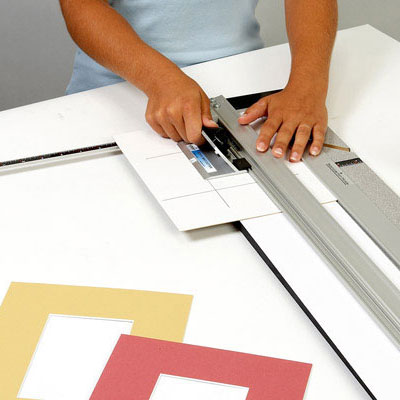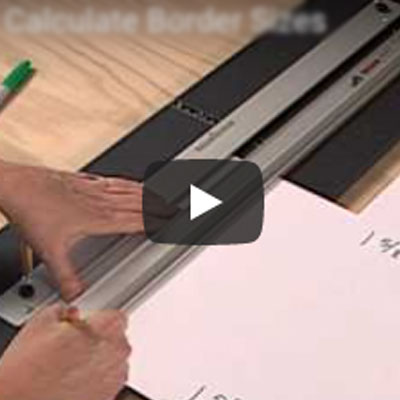When you buy a sheet of mat board today you are faced with a dizzying array of choices. Should you buy Regular Mat board or should it be Rag Mat? Should it be acid free or acid neutralized? Should it have a cream core or a white core? And the surface paper, should it be textured or smooth, pebbled or glossy? So many choices. The average person is hard pressed to digest it all.
Well, to understand what's available in mat board today, it helps to understand the progression that led to this avalanche of choices. So let's go back and see how we got to where we are today. As it turns out, most manufacturers of mat board didn't start out making mat board at all. Some were cardboard companies, and their stock in trade was signboard. The light 4 and 8 ply paper board they manufactured was ideal for making quick, easy signs.
After the second world war, the fledgling picture framing industry went in search of a low priced alternative to the dense, hard-to-work railroad board used in traditional European matting. Signboard seemed a logical choice. But from the start there were problems.
From Sign Board to Mat Board: The Problem with Acidity
First, signboard was available mostly in white or offwhite. In order to approximate the decorative flexibility of European matting, where the board is wrapped with colored paper or fabric to conceal the ugly gray core board beneath, the new board would have to be available in a variety of colors. But a dearth of colors wasn't the only obstacle. Signboard was constituted of several laminates (or plies) of paper made of wood pulp. Unfortunately, paper made from wood pulp is not long lasting.
Ah, but artwork is supposed to be long lasting and the framing that surrounds it, if it cannot enhance its longevity, at least ought not to detract from it. Wood-based paper is informed with a binding polymer called lignin. Lignin is the stuff that actually holds wood together. In direct sunlight and high humidity, and given enough time, lignin can break down, producing acid, which can seep or migrate out of the product it is in, and pass into any other product it is contact with. At the point of contact a brownish hazy affect can occur called "acid burn". To make matters worse, acid burn is a stain that cannot be removed and which signals the beginning of an ever worsening deterioration.
Barrier Papers
To the chagrin of professional framers, the potential of mat board to damage artwork was discovered. The reason it had not seemed such a big problem at first is that acid burn (or acid contamination, as it's sometimes called) is a process that can take years. So as time went on a growing number of professional framers found themselves confronted by angry customers demanding to know what had happened to their framed art.
While the mat board manufactures went to work on the problem, they advised picture framers to safeguard artwork by providing barriers between the acid bearing constituents and the artwork. Any cotton based paper would do, since cotton contains little or no lignin. Such papers came to be referred to as barrier papers, and the practice of inserting barriers between lignin bearing materials and artwork came to be known as conservation framing.
Cotton Core Mat Board
But the mat board companies didn't leave it at that. They went to work developing an alternative mat board, one in which the core of the board would be made of cotton rather than a wood-based paper. One brand of cotton core mat board was actually manufactured from recycled cotton rags, which is how it got its name, Rag Mat.
Using cotton core mat board, framers could return to placing the mat in direct contact with the artwork and forego the time consuming practice of cutting and placing barrier papers between the mat and the artwork. Yet the cat was out of the bag, so to speak. The horror of finding professionally framed artwork ruined after years of hanging innocently on walls, had made many framer's gun shy. Particularly those with the most to lose, such as museums or those framing expensive original art.
Museum Grade Rag Mat Board
Museums pointed out that the problem with acid was not just that it seeps into that which it is in direct contact with, but that it can migrate through layers and, given enough time, contaminate the barriers as well.
The mat board manufacturers quite reasonably pointed out that such migration through barriers could take more than a hundred years, but the museums were still concerned. After all, their artwork needed to be protected for centuries. Also, they pointed out, Rag Mat was not strictly speaking, 100% lignin free. While the core board and backing papers were indeed made of cotton and thus acid and lignin free, the face papers that were laminated onto the core to give the board its color and texture were the same wood-based face papers used in regular mat board. Couldn't, therefore, acid migrate out of the face paper, contaminate the core and eventually become a threat to the artwork?
Acid Neutralization
The mat board manufacturers agreed that this was possible, albeit unlikely for many, many decades, and took measures to address the problem. By putting the wood-based face papers through a bath of calcium-carbonate, they were able to balance the pH rendering the acid content in the face papers "neutralized".
In other words, the face papers could still potentially become acidic, but the acid could do no harm, or at least not until acids floating freely in the air assaulted them for such a prolonged period that the pH became unbalanced again, favoring the acid. This, they pointed out, could take well more than a century.
Yet many museums were still unsatisfied. What they wanted was a mat board that was 100% lignin and acid-free through and through. Moreover, they wanted the lignin-free, acid-free matboard neutralized to protect against free floating acid in the air.
The mat board companies obliged, coming up with a new product for the ultimate in protection, the aptly named Museum Board. Or, as one brand calls it, Museum Rag 100 - meaning 100% protection.
Acid Neutralized Regular Mat Board (Paper Board)
At about the same time the mat board manufacturers took measures to end the problem of acid contamination resulting from the use of regular wood pulp based mat board, they began putting all of their mat board through a neutralizing process, rendering the acid content harmless for a period of perhaps as long as a hundred years.
So the acid problem that had afflicted the industry since its inception had now been thoroughly addressed and three distinct types of mat board emerged.
Regular Mat Board, sometimes called Paper Board: a wood pulp based acid neutralized mat board, the industry standard and the most popular kind.
Rag Mat Board: a cotton core and cotton backed mat board with acid neutralized face papers, used widely by commercial frame shops and those seeking an extra degree of protection.
Museum Rag: a 100% cotton mat board used by museums and those seeking the highest level of protection.












